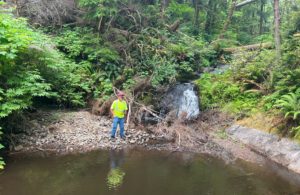
By QUINTON SMITH/YachatsNews
YACHATS — A nearly bone dry June and the prospect of little rain in July and August likely means some water restrictions coming to Yachats.
The question is when.
The key for coastal water providers is the amount of rain their areas receive in May and June. A wet spring usually means lots of water through the summer; a dry spring and there could be trouble ahead.
YachatsNews gathers rainfall totals each month from 6-7 weather watchers who live around the area, including three at various points along the Yachats River. For Jim Adler, who lives three miles upriver, it was the driest June in his 14 years of record keeping. Adler measured .26 inches of rain in June; his average has been 3.73 inches. That follows a very dry May — Adler had .61 inches that month, compared with his 14-year average of 5.3 inches.

Yachats has two sources of water – Reedy and Salmon creeks – and one treatment plant that can produce 450,000 gallons of water a day. The city system can store 1.7 million gallons of water and has just under 1,000 customers, including 20 commercial accounts — six of which account for 35 percent of all water consumption in the city.
A good predictor of water availability for the city of Yachats’ use would be Adler’s rain gauge. His gauge is near Reedy Creek, the largest of two water sources for the city, and the one that flows directly into a pond at the city’s water treatment plant.
Yachats can institute first phase of water restrictions when the total flow in both creeks drops below 275 gallons per minute. City water plant operator Rick McClung was not available Thursday to give a current reading.
Although the city does not pull water from the Yachats River, it uses flow there as another indicator and can institute use restrictions when its flow drops below 35 cubic feet per second. On Thursday the flow was 22 cubic feet per second, according to the Oregon Water Resources Department, less than half of what it was a month ago.
The city last had to institute “Phase 1” water restrictions in September 2019 and August 2018.
The “Phase 1” rules restricts the watering of lawns, gardens and landscaping to alternate days depending on odd-even house addresses, allows the sale of water only to current customers, prohibits fire drills, hose and hydrant testing and truck washing by the Yachats Rural Fire Protection District, and prohibits use of water in ornamental fountains unless there is a recirculation system.
But McClung has said in the past that Phase 1 restrictions usually result in greater use because people become aware of the issue and begin to water their property more.
Yachats last instituted tighter Phase 2 water use restrictions in 2015.
As usual, demand peaks on the weekends when more tourists are in town, McClung says, using up to 250,000 gallons a day. Demand usually peaks over the Fourth of July holiday and stays steady through August.
Here’s what YachatsNews’ other weather watchers reported for June:
- City of Yachats: .29 inches for the month and 33.73 inches total for 2023 measured at the waste treatment plant;
- Adam Altson: .35 inches for the month and 36.13 inches for the year measured at West Sixth Street and Ocean View Drive;
- Julie Bailey: .41 inches for the month and 40.05 inches for the year measured at the 220-foot level of Radar Road;
- Bob Williams: .31 inches for the month and 60.83 inches for the year measured at the 8 mile mark of Yachats River Road.
- Donald Tucker: .27 inches for the month and 36.30 for the year two miles north of Yachats. It was Tucker’s second-lowest total for June in 16 years of record keeping.



Sounds like this will be happening soon. Please refrain from watering gardens and lawns before Phase 1 is instituted. It is tempting I know but it only makes it worse.